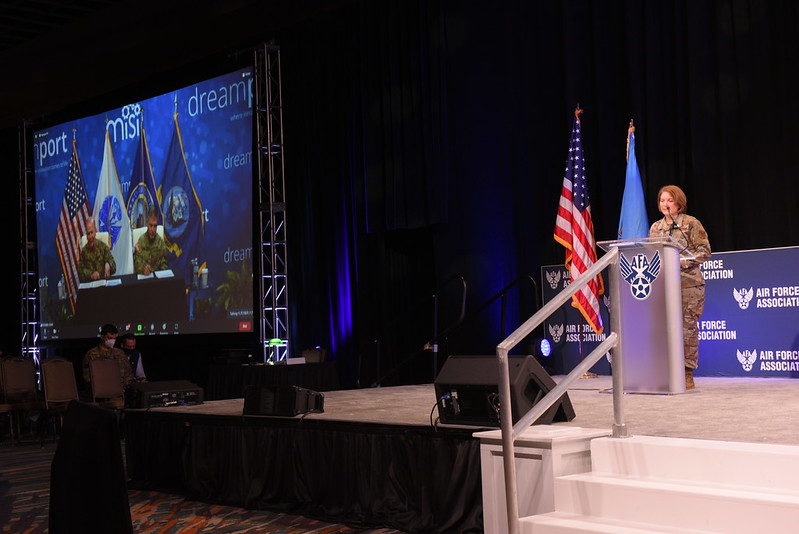Divergent ways of thinking about time were among the more unexpected challenges to joint cyber operations highlighted by commanders from three different services in a panel discussion at the AFA Warfare Symposium in Orlando, Fla., on March 4.
Combatant commanders tend to focus on current engagements in the continuum of competition with adversaries employing hybrid tactics below the level of armed conflict, said Lt. Gen. Timothy D. Haugh, commander of the 16th Air Force and Air Force Cyber Command. “How do they use our overall [cyber] force to be able to engage an adversary today in the information environment or in cyberspace [in a way] that creates advantage?”
For leaders of the geographic combatant commands, the question is: “How do we engage the gray zone elements of our adversaries that are trying to create advantage for their nation? And how do we create opportunities for [the U.S.] interagency [policy and planning process] and our allies to be able to slow that advance?”
Air component commanders, by contrast, Haugh said, tend to focus on a longer time horizon—working out how information operations and cyber forces could assist their efforts to surge forces and work with allies in response to crises like the current one in Europe.
For air component commanders, Haugh said, “It’s about how do they enable their dynamic force employment? How do they amplify their exercises with allies and partners to strengthen resolve as part of the areas that could be enabling for agile combat employment? As we think about our partners and how we will work together in an area of crisis or conflict.”
Time, in the form of time at sea, was also on the mind of the Navy’s top cyber warrior, 10th Fleet and U.S. Fleet Cyber Commander Vice Adm. Ross Myers. The Navy faced a tougher challenge in recruitment and retention than the other services, he said. In the Navy, in addition to the same wage gap with the lucrative jobs that top cyber warriors could land in the private sector, “we do go to sea. And not everybody that’s inclined in cyber is necessarily inclined to spend months at sea.”
Combine that with the nationwide shortage of cyber talent, Myers added, and “We’re in a constant battle to acquire and retain a combat ready [cyber] force.”
Like in all the services, Myers said, a generation of Navy leaders who came into a service without email are challenged to relate to the digital natives they now command.
“It’s hard for me to relate to a 20-year-old that lives with an iPhone in their hand. That’s their means of communication … and they live and breathe with that thing. They sleep with it. That is foreign to me,” he said. “But it does not diminish the fact: Leadership is leadership. Whether it’s electronic, or whether it’s physical, it still demands and requires all of us to be good leaders.”
“In truth and reality, the Navy [had] some of the last units to go … into the electronic age,” said Myers, who entered the service in 1986. “When I came in the Navy, we were still doing letter mail. Email addresses didn’t exist,” he recalled, noting that he now leads a fleet “where I guarantee you there are sailors that have never received a letter at sea. The only thing they’ve received are emails.”
Like other digital natives, young Navy service members took connectivity for granted, added Myers. “If you want to come close to a mutiny, cut off the internet connection … for more than a few hours, and offer no explanation for it,” he said.
Army Maj. Gen. William “Joe” Hartman, commander of Cyber Command’s National Mission Forces, admitted that he, too, entered the service in the pre-email era. But he said he learned the basics of cybersecurity from the legendary “Ranger Handbook: Five Principles of Patrolling,” one of which was security.
“Until you had security, you couldn’t do anything else. And that’s the environment that we’re still in. And for a network operation, it starts with security,” Hartman said. “Once your network is secure, you can then communicate those important things you need to, and you can make those decisions that as a senior leader you need to make. But if you’re unclear on the security of your network, you shouldn’t make any decisions. You shouldn’t take any actions, until your network is secure. And that’s a little bit blunt. But that just is the way that we’ve always operated in the Department [of the Army].”
Even leaders from the pre-email era had families who tended to take connectivity for granted, said Lt. Gen. Mary F. O’Brien, Air Force deputy chief of staff for intelligence, surveillance, reconnaissance, and cyber effects operations, who moderated the discussion.
“When I was deployed to Afghanistan,” she recalled, “my son said, ‘Mom, are you going to have WiFi in Kabul, so you can order my saxophone reeds and schedule my lacrosse camp?’ And I said, ‘Yes, I will,’ and he goes, ‘OK, we’ll be fine.’”
